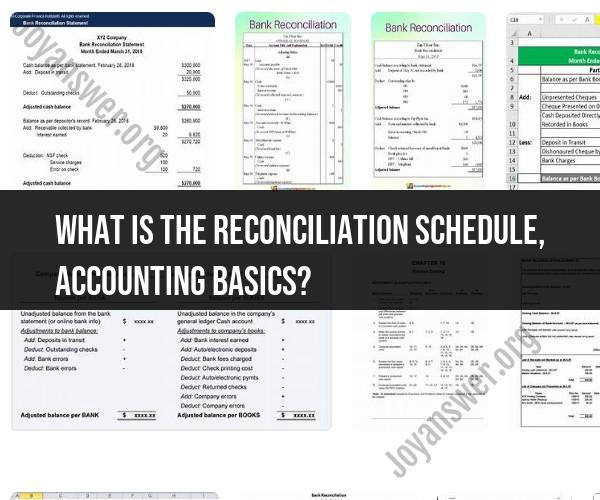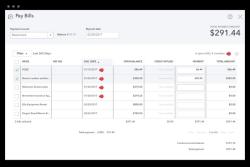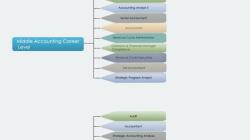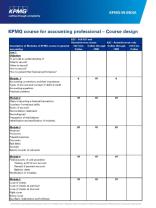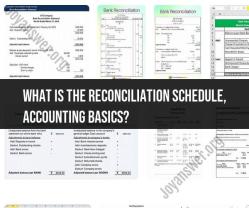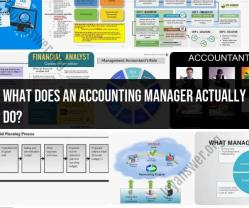What is the reconciliation schedule, accounting basics?
A reconciliation schedule in accounting is a financial document or report that is used to ensure that two sets of financial records are in agreement or "reconciled." The primary purpose of reconciliation is to identify and resolve discrepancies or differences between the records. This process is crucial for maintaining the accuracy and integrity of financial data. Here are the basics of reconciliation schedules in accounting:
1. Purpose of Reconciliation:
- To verify that two sets of records or accounts match and agree with each other.
- To identify and rectify errors, omissions, or discrepancies in financial data.
- To ensure that financial statements and reports accurately reflect the company's financial position.
2. Types of Reconciliation Schedules:
- Bank Reconciliation: This is one of the most common types of reconciliation. It involves comparing a company's cash records (bank statement) with its internal cash records (cash book or ledger). Differences can arise due to outstanding checks, deposits in transit, bank fees, or errors.
- Inventory Reconciliation: Companies often reconcile physical inventory counts with their recorded inventory balances to identify any discrepancies due to theft, spoilage, or recording errors.
- Accounts Receivable and Accounts Payable Reconciliation: These reconciliations ensure that the amounts owed to and by the company match with external records, such as customer invoices and supplier bills.
- General Ledger Reconciliation: This involves comparing various general ledger accounts to subsidiary ledgers or supporting documentation to ensure that all transactions are properly recorded.
- Credit Card Reconciliation: Companies reconcile their credit card statements with their internal records to verify all credit card transactions and identify discrepancies or errors.
3. The Reconciliation Process:
- Start by listing the beginning balance of both sets of records that need to be reconciled.
- Compare individual transactions or items one by one, ensuring that they match in both sets of records.
- Investigate and document any discrepancies or differences.
- Make adjustments or corrections as necessary to bring the records into agreement.
- Calculate and document the ending balance for both sets of records after reconciliation.
4. Frequency of Reconciliation:
- The frequency of reconciliation varies depending on the type of account or record. For example, bank reconciliations are often performed monthly, while inventory reconciliations may be done periodically or annually.
5. Importance of Reconciliation:
- Detects and prevents errors and fraud.
- Ensures the accuracy of financial statements and reports.
- Helps in identifying cash flow issues and liquidity problems.
- Provides confidence to stakeholders, such as investors, lenders, and auditors, in the reliability of financial information.
In summary, reconciliation schedules in accounting are vital tools for ensuring the accuracy and reliability of financial data. They help companies identify and resolve discrepancies, maintain financial integrity, and provide stakeholders with confidence in the company's financial reporting. Reconciliation should be a regular practice in any organization to minimize the risk of errors and fraud in financial records.
Demystifying Reconciliation Schedules in Accounting
A reconciliation schedule is a financial statement that compares two sets of accounting records to ensure that they are accurate and in agreement. It is a common accounting practice that is used to identify and correct any errors or discrepancies in the records.
Reconciliation schedules can be used to reconcile a variety of different accounts, including:
- Bank accounts
- Credit card accounts
- Accounts receivable
- Accounts payable
- Inventory
- Fixed assets
Components and Importance of a Reconciliation Schedule
A reconciliation schedule typically includes the following components:
- Account name: The name of the account being reconciled.
- Book balance: The balance of the account as shown in the general ledger.
- Supporting balance: The balance of the account as shown in the supporting records, such as a bank statement or vendor invoice.
- Difference: The difference between the book balance and the supporting balance.
- Explanation: An explanation of any differences between the book balance and the supporting balance.
Reconciliation schedules are important because they help to ensure the accuracy of financial statements. By regularly reconciling accounts, accountants can identify and correct any errors or discrepancies, which can help to prevent fraud and other financial problems.
How to Prepare and Analyze a Reconciliation Schedule
To prepare a reconciliation schedule, you will need to gather the following information:
- The account name
- The book balance
- The supporting balance
Once you have gathered this information, you can begin to prepare the reconciliation schedule.
To do this, simply list the account name, book balance, supporting balance, and difference in a table. Then, provide an explanation for any differences.
Once you have prepared the reconciliation schedule, you should review it carefully to ensure that it is accurate and complete. You should also compare the reconciliation schedule to the previous reconciliation schedule to identify any trends or patterns.
Here are some additional tips for preparing and analyzing reconciliation schedules:
- Use a standard format. This will make it easier to prepare and review reconciliation schedules over time.
- Include all relevant information. Make sure to include the account name, book balance, supporting balance, difference, and explanation for any differences.
- Reconcile accounts on a regular basis. The more often you reconcile your accounts, the easier it will be to identify and correct any errors or discrepancies.
- Compare reconciliation schedules to previous reconciliation schedules. This can help you to identify any trends or patterns.
If you have any questions or concerns about preparing or analyzing reconciliation schedules, you should consult with a qualified accountant.
